The following reviews were first published in the British Music Society
newsletter and are published here with M. Culot's very kind permission. Rob
Barnett:-
ALWYN. Symphony 5 "Hydriotaphia"
(1973); Sinfonietta for Strings (1970); Concerto
2 for Piano and Orch (1960) Howard Shelley, piano; LSO/Hickox
CHANDOS CHAN 9196
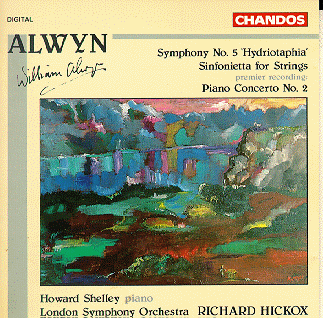
Alwyn's Symphony No. 5 came many years after his fourth. In the meantime
he devoted much time to other works, especially his two operas, Juan or
The Libertine and Miss Julie. It shows a considerable evolution
in his symphonic manner though retaining many of his fingerprints. It is
much shorter, and more tightly knit than its predecessors and the scoring
is more imaginative than ever. Along with the Sinfonietta and his String
Trio, it is among his more significant pieces. Commissioned by the Arts Council
for the 1973 Norfolk and Norwich Triennial Festival, the Fifth Symphony is
dedicated "to the immortal memory of Sir Thomas Browne, author of a great
elegy on death 'Hydriotaphia: Urn Burial'". Each section is headed by a quotation
from Hydriotaphia, but the work is not programmatic.
As usual in Alwyn's symphonies, Symphony 5 is based on a motto, present
throughout the piece under various guises, ensuring coherence of the musical
material. Alwyn's other masterpiece, the superb Sinfonietta for Strings
also appears, belonging to roughly the same period but is very different.
The diminutive title is misleading; the symphonic argument is as tight as
ever and any composer, less modest than Alwyn, would have happily entitled
it 'Symphony'. It may be Alwyn's most densely contrapuntal piece whose language
is tenser and sparer than in most of his other works. It is sombre and elegiac.
The string writing is forceful, athletic, sometimes reminiscent of Honegger.
The deeply felt slow movement includes a quotation from Alban Berg's Lulu
woven effortlessly into the typical Alwynian fabric. After a nervous
start, the finale is curiously slow and ends with a quiet questioning coda.
A full body of strings is called for and the LSO, in top form, give it a
full-blooded performance.
Piano Concerto 2 was written for the Dutch pianist, Cor de Groot who
had first performed the Twelve Preludes of 1957. De Groot's sudden paralysis
prevented its performance, planned for the Proms. It was put aside and has
never been performed. Alwyn seems to have worked on it some time later, cutting
out the slow movement and replacing it with a short bridge passage between
the outer fast movements. Alwyn restored the original Andante and so had
to rework the end of the first movement. This is the version used on this
disc. The work, unmistakably Alwyn throughout, is traditional with a popular
appeal that could have made it a huge success with Proms audiences. It is
well worth hearing but may not be among Alwyn's best works. When I visited
him in 1984, he confirmed the existence of the work but saying little about
it. Howard Shelley plays the concerto with the utmost conviction and gets
strong support from the LSO.
© Hubert Culot.
ALWYN Symphony 3 (1955/6);
Concerto for Violin and Orch. (1937/9) Lydia Mordkovich,
LSO/Hickox. CHANDOS CHAN 9187
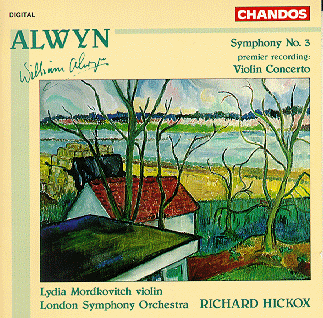
This release couples two major Alwyn works. The concerto considered by Sir
Henry Wood for Prom performance lay forgotten for nearly fifty years. It
plays some forty minutes. Big in size and content. The first movement is
the longest and weightiest. A big orchestral introduction heralds the soloist's
first entry. The violin then has the main argument with vital orchestral
contributions. The end is quiet so that the transition to the slow movement
is smooth, emphasising the work's global concept. Flowing tunes abound,
particularly in the slow movement - a song without words, characteristic
of so many of Alwyn's. The third movement begins quite fast, alla marcia,
leading to a first powerful climax (the theme here bears a resemblance to
that of the finale of Ireland's Piano Concerto). Moderate tempo is resumed
and maintained with abrupt orchestral outbursts. A second bright climax leads
to a brilliant conclusion. The work, shows the way to the 1949 Symphony No
1 with which it shares characteristics: weight of argument, abundance of
ideas, sureness of touch and above all flawless musicality. Why has such
a masterly work remained unperformed for nearly fifty years? Mordkovich is
superb and the orchestra play with conviction and confidence.
Symphony 3 is a major work of Alwyn's maturity and the most dramatic of his
symphonies. There is devastating energy and the outer movements teem with
furious outbursts, verging on violence. The beautifully appeased slow movement
provides respite before the onslaught of the warlike final movement where
Holstian echoes can be spotted. This dissolves in a peaceful epilogue ending
with an abrupt question mark. The work's tension remains unresolved. Perhaps
Alwyn's most pessimistic work, it was written under the shadow of the Cold
War when another world conflagration was possible. A glimpse into Alwyn's
personal brand of serialism is revealed. Sir Thomas Beecham first performed
the symphony to a good reception by critics and audience. John Ireland considered
it the best British symphony since Elgar's Second. Hickox and the LSO seem
to share the view for they perform this deeply personal masterpiece superbly.
Chandos's recording does full justice to Alwyn's masterly scoring.
Hubert Culot
ALWYN Symphony No 2 (1953);
Overture to a Masque (1940); Symphonic Prelude The Magic
Island ( 1952); Overture Derby Day (1960);
Fanfare for a Joyful Occasion (1948). LSO/Hickox. CHANDOS
CHAN 9093
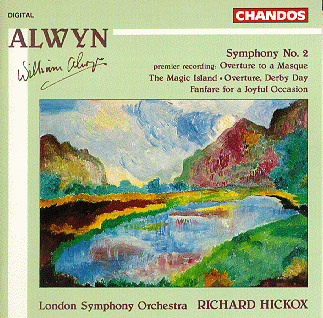
Most pieces on this record have been available earlier (Lyrita and Unicorn).
The novelty here is the comparatively early Overture to a Masque
completed in 1940, not performed then for obvious reasons. It has never
been performed; the score was recently found in the LSO archives. This enjoyable
short piece belongs to the British 'main stream music' of that period. It
is expertly written and brilliantly orchestrated and, listening to the next
item in this CD, the much later symphonic prelude The Magic Island
written for Sir John Barbirolli and the Hallé, one can appreciate
the evolution of Alwyn's writing. The scoring of the prelude is more imaginative
and resourceful than the earlier work. The overture Derby Day was
written in the wake of Symphony No 4, completed in 1959. Another short colourful
work, it could, heard more often, become popular with audiences. Both The
Magic Island and Derby Day belong to Alwyn's maturity and show
a clear stylistic progress and a richer orchestral writing compared to the
Overture to a Masque. Fanfare for a Joyful Occasion is scored
for brass and percussion. A delightful, brilliantly written work it has many
nice instrumental details, especially in the percussion. It provides a bright
conclusion to a very fine CD.
Symphony No 2, the major item, was written for Sir John Barbirolli and the
Hallé who premiered the Symphony No 1 (1949) and The Magic
Island. It is much shorter than its predecessor but is possibly the best
example of Alwyn's symphonic thinking. Most of the material derives from
the bassoon theme of the very first bars of the first movement. A few other
elements stated from the early stages of the symphony also play an important
part, giving clear coherence to the symphonic argument throughout. The work's
beautiful epilogue is entirely based on the bassoon theme played in turn
by strings, woodwind and finally by the brass as a chorale. Symphony No 2
is a tightly argued work full of fine moments. It is easy to see why it was
the composer's favourite symphony.
The fourth release in Chandos's Alwyn cycle, this is of the same excellent
quality as the earlier ones. The LSO is in fine form throughout. Brass and
percussion are superb in the brightly scored Fanfare For A Joyful
Occasion. This CD also offers the first performance and recording of
an early work that is well worth unearthing and likely to appeal to audiences.
Richard Hickox again confirms his sympathy for and understanding of Alwyn's
music.
© Hubert Culot
WILLIAM ALWYN Symphony 1
(1944) Piano Concerto 1 (1930) Howard Shelley, piano;
LSO/Hickox CHANDOS CHAN9155
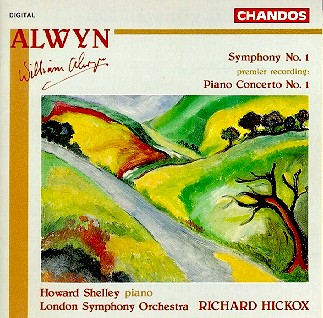
Of many disowned pieces, Alwyn apparently considered his first piano concerto
the best of them. The concerto, written for and premiered by Clifford Curzon
with the Bournemouth SO conducted by the composer, is a fine work. Influences
are easy to trace: Prokofiev and Ireland appear but the work exhibits too
a quite remarkable sureness of touch, especially in the orchestral part,
already signalling Alwyn's mature writing. The one movement work falls into
four clear sections: an energetic opening allegro domino is followed by a
slow section leading to a varied restatement of the opening music immediately
followed by a peaceful epilogue ending with a sustained string chord, perhaps
the most remarkable part of the whole. The work may be Alwyn's first most
significant work and worthy of revival. It is superbly performed and will
surely earn new sympathies.
Symphony 1 was completed at least twenty years after the piano concerto.
Meanwhile, Alwyn had written much film music, gaining technical mastery of
a broader orchestral palate, evident in this symphony. There are still
influences, notably that of Sibelius, but - more importantly - Alwyn's mature
symphonic manner (to be further refined over the years culminating in Symphonies
4 and 5 "Hydriotaphia" and the Sinfonietta for Strings) is affirmed. There
are four movements, an energetic scherzo placed second. Among the many Alwyn
fingerprints is the use of germinal cells on which the rest of the symphony
builds. Thematically rich, the work has many instrumental felicities, instanced
by the magnificent horn tune in the second movement. The slow movement is
a simple ABA form and essentially song-like in character. It is based on
two main themes: the first stated by the cor anglais after a 3-bar introduction
given by the horns and the second one by the violas somewhat later. This
theme dominates most of the movement. Alwyn described the fourth movement
as "probably the most extrovert piece (I have ever) written". The themes
almost run riot and the music is rushed to a brilliant conclusion.Hickox's
reading of the work is fine - further proof of his affinity with and feeling
for Alwyn's music. The LSO play well throughout. © Hubert Culot.
WILLIAM ALWYN. Concerto for Oboe,
String Orch & Harp (1944/5) Concerti Grossi 1 in B flat
(1943) 2 in G (1948) 3 (1964).
Nicholas Daniel, oboe; City of London Sinfonia/Hickox CHANDOS CHAN 8866
Symphony 4 (1959) Elizabethan Dances (1956/7)
Festival March (1950) LSO/Hickox CHANDOS CHAN 8902
These first two CDs of an Alwyn cycle planned by CHANDOS should yield many
riches, including a number of hitherto unrecorded works as well as some already
commercially available. Issue 1 offers three firsts; all the Concerti Grossi,
except C.G.2 are new to recording. C.G.1 is dedicated to 'my friends in the
LSO". It is the earliest item preserved by Alwyn who discarded most of his
pre-1940 works, and a rare example of Alwyn's neo-classicism which he was
soon to abandon. A vigorous fanfare-like first movement is followed by a
delicately-scored Siciliana. This delightful work closes with a Vivace "with
a restatement of the original trumpet theme on the full orchestra". The Concerto
for oboe, string orchestra and harp is one of Alwyn's few excursions into
the pastoral mood once favoured by some British composers. It is in two movements
played without a break: the first, a Moderato with a more animated middle
section, leads into a dancing Vivace. This beautiful short work deserves
more hearings.
William Alwyn recorded his C.G.2 with the LPO (LYRITA SRCS 108). It is scored
for strings including a solo quartet and is beautifully laid out for them.
The fine slow movement has the quartet in dialogue with the full body of
strings and is lyrical in Alwyn's finest vein. These beautiful works definitely
deserve more hearings . Subtitled 'Tribute to Sir Henry Wood' the C.G. 3
is a short, enjoyable work containing forceful brass writing and many fine
moments for strings an woodwind. It is virile, devoid of any neo-classical
gestures and ends with a deeply-felt Andante.
The second disc groups three very different works belonging to the same decade.
The Festival March was written for the 1951 Festival of Britain. It follows
the pattern of Elgar's and Walton's marches, but Alwyn remains himself. The
Elizabethan Dances were written for the 1957 Light Music Festival and show
Alwyn's lighter side. This is superbly-scored music and the whole set is
another example of Alwyn's orchestral flair and mastery. These dances could
be as popular as Arnold's various dance sets, though less flamboyant. Both
the Festival March and four of the Elizabethan Dances (1,2,5,4 [sic]) were
recorded by Alwyn (respectively LYRITA SRCS 99 and SRCS 57); the present
recording is the first of the complete set.
The 4th Symphony is in three movements of fairly equal length: the first,
Moderato, the second a longish Scherzo and the third another Moderato. Thus
the plan bears some resemblance to Rubbra's 7th of 1957. All three movements
are dominated by a motto heard at the outset, a practice already present
in Alwyn's earlier symphonies. The conflict, started in the course of the
first movement, gets more power in the restless Scherzo, while the third
movement, a Passacaglia, brings the work to a triumphant conclusion in which
the ostinato from the scherzo, briefly restated, launches the epilogue which
ends on a bright chord.
All five Alwyn symphonies, his Sinfonietta and Harp Concerto - "Lyra Angelica"
- and some shorter works were recorded by LYRITA in a mini-cycle, all played
by the LPO under the composer. These recordings were superb and still sound
well. The composer's conducting lent authenticity to the fine performances.
Hickox's readings are along similar lines. He conducts all the works with
his customary understanding, sympathy and commitment. His performance of
the 4th Symphony is superb throughout and the warmth of the recording suits
Alwyn's lyricism. Both orchestras are fine and the LSO play the music of
their former colleague with affection, conviction and assurance. The standards
of recording and production are up to CHANDOS's highest; they are to be thanked
and congratulated for this large-scale enterprise that might prove as significant
as their Bax and Walton series Newcomers to Alwyn might start with the Concerti
Grossi CD since that provides a useful survey of Alwyn' s progress between
1940 and 1960. Others will need no further recommendations to get both discs
and look out for further releases in this major venture.
Hubert CULOT
WILLIAM ALWYN
Odd Man Out Suite (1946)
The History of Mr Polly Suite (1949)
The Fallen Idol Suite (1948)
Calypso from "The Rake's Progress" (1945)
London Symphony Orchestra - Richard Hickox
CHANDOS CHAN 9243
String Quartet No.1 in D minor (1955)
String Quartet No.2 "Spring Waters" (1975)
Quartet of London
CHANDOS CHAN 9219
Invocations (1978)
A Leave-Taking (1977)
Jill Gomez, soprano - John Constable, piano
Anthony Rolfe-Johnson, tenor - Graham Johnson, piano
CHANDOS CHAN 9220
Fantasy-Waltzes (1955)
Twelve Preludes (1957)
John Ogdon, piano
CHANDOS CHAN 8399
The last three records under review were first issued in LP format in the
1980s and late 1970s.
The first string quartet is an outstanding example of Alwyn's lyricism and
stylistically belongs to the same period as the THIRD SYMPHONY and the FOURTH
SYMPHONY. It is in four movements of which the wonderful slow movement is
the emotional heart. The second string quartet, subtitled "Spring Waters",
is a very different piece. It is in turn more uneasy, restless, sharp-edged,
more violent and aggressive than its predecessor. It is also imbued with
bitter-sweet feelings foreign to the lyrical mood of the first string quartet.
Even the big unison near the end of the third movement does not sound as
triumphant as the composer might have wished. The performances by the Quartet
of London are very fine and it was their superb first performance of the
second string quartet that induced the composer to write another quartet
for them. This would materialise a few years later when Alwyn completed the
third string quartet which they first performed in 1984.
Alwyn composed several song cycles each as a homage to the singers who took
part in the original broadcast performance of his opera MISS JULIE. A
LEAVE-TAKING to words by Lord de Tabley was written for Anthony Rolfe-Johnson
whereas INVOCATIONS to words by Michael Armstrong was composed for Jill Gomez.
Alwyn's song writing at its best may compare with John Ireland's and some
of the songs are on a grand scale. Both song cycles receive superb performances
from singers and pianists alike, for the piano parts are far from being mere
accompaniments. There is a slight difference in acoustics between these
recordings, A LEAVE-TAKING being given a much more natural balance than the
other cycle. Anyway it must be said that this release is a very fine one
indeed and a worthwhile addition to Alwyn's discography.
Alwyn wrote four large-scale piano works. The FANTASY-WALTZES of 1955 benefits
from John Ogdon's wonderful playing. Ogdon's sympathy with the music is evident
throughout and he obviously relishes Alwyn's brilliantly assured piano writing.
Originally the FANTASY-WALTZES should have been a suite of short characteristic
pieces in waltz rhythm but the work rapidly outgrew the composer's intentions.
Finally it became a big work full of contrasts, invention and colour, a true
kaleidoscope in waltz form. The TWELVE PRELUDES (1957) explore much stricter
material than the FANTASY-WALTZES and belong to the "serial" world of the
third and fourth symphonies and of the STRING TRIO. Each prelude has a clearly
defined character and the whole piece makes for a well-contrasted suite.
The fifth prelude was written in memory of Richard Farrel who was the dedicatee
and the first performer of the FANTASY-WALTZES. It is the emotionally weightier
one of the set.
The last record in this batch of Alwyn from CHANDOS is a most welcome release
and one for which I have been praying for many years. In the too brief period
in which I was privileged to know William Alwyn, I somewhat naively suggested
that he should make concert suites out of his best film scores. He then
regretfully told me that the scores were destroyed in the late fifties when
a fire destroyed Pinewood Studios thus causing the loss of many of his great
film scores as well as those of Walton and others. After Alwyn's death Mary
Alwyn set about sorting her husband's papers and found a number of sketches
of some film scores including ODD MAN OUT and a complete photocopy of the
score for THE FALLEN IDOL. The late Christopher Palmer prepared some suites
which are here recorded for the first time. Alwyn composed some 200 film
scores covering documentary films, fiction features and even three Disney
films.
Alwyn considered writing for films as serious a task as writing a symphony
or a string quartet. He used to do the orchestration himself which is why
his film music shares the same world as his serious works for the concert
hall. Alwyn was also happy in collaborating with noteworthy directors who
involved him from the start in the making of the film. Carol Reed was much
interested in the role of the music in his films.
His magnificent film ODD MAN OUT of 1946 is the only one the above-mentioned
films that I have seen. It made a deep impression and I found the music
wonderful. Hearing it afresh now confirms my feeling that the music for ODD
MAN OUT is really a great score, and quite simply a great piece of music.
The opening music rises to symphonic proportions while the long final scene
in which the wounded IRA gunner (James Mason) painfully makes his way to
the docks entirely rests on the music that has to support the action till
the end of the film. It is a long symphonic movement that opens in a mood
similar to that of the Passacaglia of the first violin concerto of Shostakovich.
It is a powerful March to the Abyss cut short by two gun shots and ending
with a short appeased coda. ODD MAN OUT and SHAKE HANDS WITH THE DEVIL (1959)
are probably among Alwyn's greatest scores and really transcend film music.
The score for THE HISTORY OF MR POLLY (1949) is of course somewhat lighter
but again it is superb full of fine touches such as the exhilarating Punting
Sequence which is a brisk and joyful Scherzo for woodwind. THE FALLEN IDOL
(1948) is another beautiful score and also belongs amongst his most successful.
It is full of invention and of masterly orchestral strokes such as the superb
Scherzo "Hide and Seek" of which the rather ghastly mood is enhanced by the
scoring for muted strings and muted brass. These three film scores are evident
examples of the importance that Alwyn attached to his music for films. They
are sizeable spans of music and each suite lasts some twenty minutes, that
of ODD MAN OUT lasting some twenty-six minutes.
This says a lot about the real musical quality of these scores which are
important milestones in Alwyn's large and varied output. The last item of
this fine release is the highly enjoyable "Calypso" from THE RAKE'S PROGRESS
(1945). Here Alwyn writes a very fine mood piece somewhat reminiscent of
Milhaud in his South-American mood. One could not have dreamed a finer conclusion
to this indispensable record which I unreservedly recommend. I am a bit short
of superlatives to praise the performances and the playing of the London
Symphony Orchestra conducted by Richard Hickox who again demonstrates his
deep sympathy with and feeling for Alwyn's music.
© Hubert CULOT
WILLIAM ALWYN Chamber Works
Sonata for Clarinet and Piano (1962)
Divertimento for Solo Flute (1939)
Crepuscule - Solo Harp (1955)
Sonata for Oboe & Piano (1934)
Sonata for Flute & Piano (1948)
Sonata Impromptu for Violin & Viola (1939)
Nicholas Daniel, oboe - Kate Hill, flute - Joy Farrall, clarinet Julius Drake,
piano - Ieuan Jones, harp - Leland Chen, violin Clare MacFarlane, viola
CHANDOS CHAN 9197
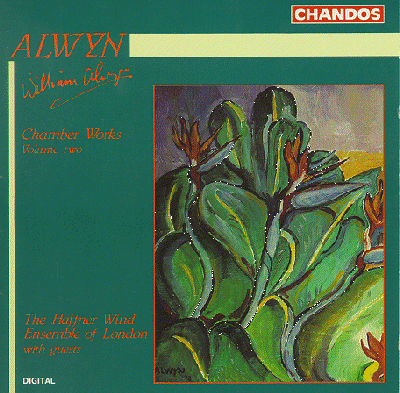
Alwyn's early chamber music was mainly written for colleagues and friends
with whom he used to play as a flautist. It is always superbly written for
the instruments and designed to exploit the instruments at their best. This
expertise was gained through numerous performances of the then modern music
(Ravel, Roussel and others). The first volume released by CHANDOS (CHAN 9152)
made this fairly clear and the second one under review certainly confirms
it.
The CLARINET SONATA written in 1962 for Thea King is a work belonging to
his most mature period. It is a comparatively short work though a tightly-knit
one laid-out in a single movement of considerable musical substance and packed
with energy. It opens with a brisk, nervous gesture immediately followed
by some more relaxed material. A very fine addition to the repertoire of
the clarinet. Much earlier is the DIVERTIMENTO FOR FLUTE written in 1939
and first performed in 1940 by Rene Le Roy at the ISCM festival in New York.
Expertly written for the instrument the piece stills shows the neo-classical
features that Alwyn was soon to abandon. As might be expected this virtuosic
piece exploits the possibilities of the flute to the full and makes serious
demands on the player. It earned its composer his first international success.
CREPUSCULE is a very short piece written for Sidonie Goossens. "The piece
is meant to suggest a cold, clear winter's night with frost snow" (Alwyn).
A delightful atmospheric piece. The OBOE SONATA of 1934 is by far the earliest
piece in this collection. The work was given at a concert of the New Music
Society and was then well received. It is in three movements: a lengthier
first movement followed by a choral-like Andantino. It ends with a livelier
finale capped by a more reflective Coda. The music is naturally more akin
to the British and (maybe more significantly still) French music of its period,
and it exhibits very little of Alwyn's fingerprints. Another worthwhile addition.
Surprisingly enough Alwyn wrote few large-scale works for his instrument.
The FLUTE SONATA of 1940 is actually very short though again of some substance.
Its one movement structure clearly falls into three sections and it again
ends with a short coda. The sonata still has some neo-classical characteristics
such as the fugue in the Allegro ritmico e feroce. The SONATA IMPROMPTU composed
in 1939 was written for Watson Forbes who played it with Frederick Grinke.
Though the piece seems to have enjoyed some performances in the 40s it has
remained virtually unheard since then. (For information's sake, this piece
is listed as SONATA QUASI FANTASIA in Poulton's "William Alwyn : A Catalogue
of his Music" [BRAVURA PUBLICATION 1985 - soon to be replaced by Poulton's
devastatingly comprehensive three volume Greenwood Press Dictionary of British
Composers].) A short prelude and fugue leads directly into a lengthier and
weightier theme and variations. The piece ends with a Finale alla Capriccio.
The sonata for violin and viola is an important addition for it unquestionably
is a big piece superbly written for the instruments and full of beautiful
moments. It is by far the most important piece in this collection (i.e. besides
the DIVERTIMENTO and the CLARINET SONATA).
The performances are all assured, confident and committed; and this beautiful
record lifts the veil on a number of nearly forgotten Alwyn works that certainly
deserve to be heard again. This record is again a worthwhile addition to
Alwyn's discography and it again helps widen our appreciation of Alwyn's
large and varied chamber output.
Hubert CULOT
|
